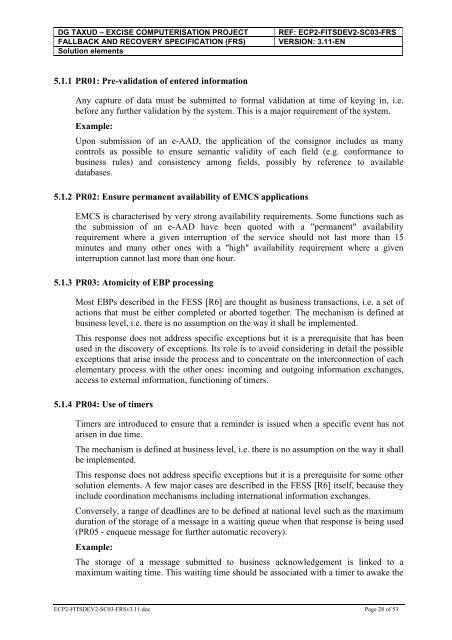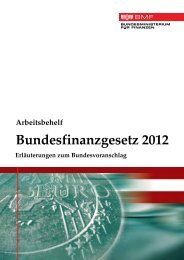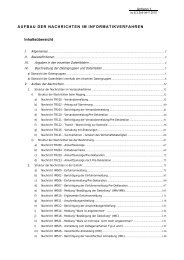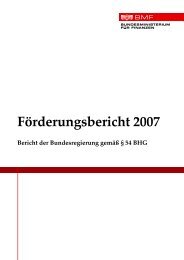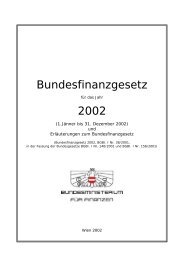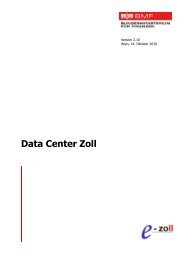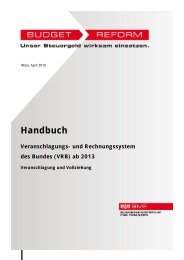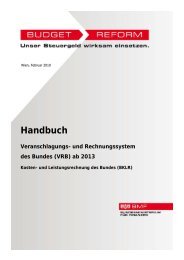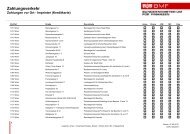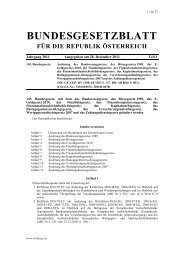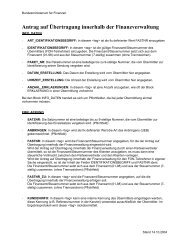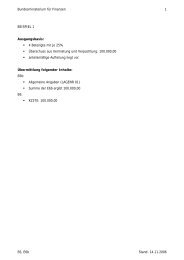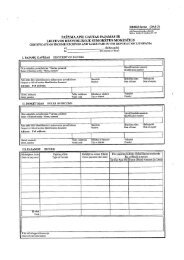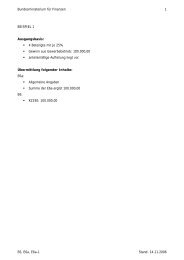Fallback and Recovery Specification (FRS)
Fallback and Recovery Specification (FRS)
Fallback and Recovery Specification (FRS)
You also want an ePaper? Increase the reach of your titles
YUMPU automatically turns print PDFs into web optimized ePapers that Google loves.
DG TAXUD – EXCISE COMPUTERISATION PROJECT REF: ECP2-FITSDEV2-SC03-<strong>FRS</strong><br />
FALLBACK AND RECOVERY SPECIFICATION (<strong>FRS</strong>) VERSION: 3.11-EN<br />
Solution elements<br />
5.1.1 PR01: Pre-validation of entered information<br />
Any capture of data must be submitted to formal validation at time of keying in, i.e.<br />
before any further validation by the system. This is a major requirement of the system.<br />
Example:<br />
Upon submission of an e-AAD, the application of the consignor includes as many<br />
controls as possible to ensure semantic validity of each field (e.g. conformance to<br />
business rules) <strong>and</strong> consistency among fields, possibly by reference to available<br />
databases.<br />
5.1.2 PR02: Ensure permanent availability of EMCS applications<br />
EMCS is characterised by very strong availability requirements. Some functions such as<br />
the submission of an e-AAD have been quoted with a "permanent" availability<br />
requirement where a given interruption of the service should not last more than 15<br />
minutes <strong>and</strong> many other ones with a "high" availability requirement where a given<br />
interruption cannot last more than one hour.<br />
5.1.3 PR03: Atomicity of EBP processing<br />
Most EBPs described in the FESS [R6] are thought as business transactions, i.e. a set of<br />
actions that must be either completed or aborted together. The mechanism is defined at<br />
business level, i.e. there is no assumption on the way it shall be implemented.<br />
This response does not address specific exceptions but it is a prerequisite that has been<br />
used in the discovery of exceptions. Its role is to avoid considering in detail the possible<br />
exceptions that arise inside the process <strong>and</strong> to concentrate on the interconnection of each<br />
elementary process with the other ones: incoming <strong>and</strong> outgoing information exchanges,<br />
access to external information, functioning of timers.<br />
5.1.4 PR04: Use of timers<br />
Timers are introduced to ensure that a reminder is issued when a specific event has not<br />
arisen in due time.<br />
The mechanism is defined at business level, i.e. there is no assumption on the way it shall<br />
be implemented.<br />
This response does not address specific exceptions but it is a prerequisite for some other<br />
solution elements. A few major cases are described in the FESS [R6] itself, because they<br />
include coordination mechanisms including international information exchanges.<br />
Conversely, a range of deadlines are to be defined at national level such as the maximum<br />
duration of the storage of a message in a waiting queue when that response is being used<br />
(PR05 - enqueue message for further automatic recovery).<br />
Example:<br />
The storage of a message submitted to business acknowledgement is linked to a<br />
maximum waiting time. This waiting time should be associated with a timer to awake the<br />
ECP2-FITSDEV2-SC03-<strong>FRS</strong>v3.11.doc Page 28 of 53


